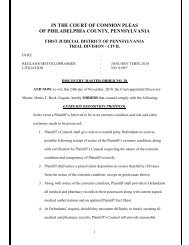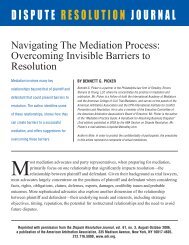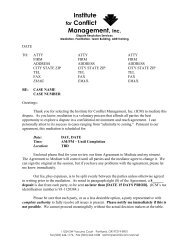The Advocate's Mediation Checklist - Mediate.com
The Advocate's Mediation Checklist - Mediate.com
The Advocate's Mediation Checklist - Mediate.com
You also want an ePaper? Increase the reach of your titles
YUMPU automatically turns print PDFs into web optimized ePapers that Google loves.
Institute forConflict Management, Inc.weeks or months of negotiation into a single day (mediation is sometimes called “Turbo-chargedNegotiation”). Do not, in any event, be constrained by your negotiating plan. Remain flexiblewith the process, but never let the mediator control your side of the negotiation. You and yourclient are in charge.1. Be able and willing to try your case if the matter doesn’t settle!2. Confer with your client on:a. <strong>The</strong> advocate’s role during the discussions - prepare them for the fact that you will notbe stylistically aggressiveb. <strong>The</strong> client’s role during the discussionsc. <strong>The</strong> role of the mediator, the typical mediation process3. Determine who needs to be there:a. Attorney, CPAb. Party with full settlement authorityc. Consider experts and consultants4. Learn as much as possible about your client’s and the opponent’s:a. Stated facts (depositions not necessarily required but informal discovery exchange maybe helpful)b. Understanding of the lawc. Negotiating styled. Issuese. Perceived business & personal needsf. expectationsg. Perceptions and decision-making styleh. Outside influences on the negotiationi. Openness to creativityj. Value of ongoing relationship, if any5. Do some “reality testing” with your client.6. Do unresolved legal matters impact your willingness to settle?7. What is the relationship between the advocates?8. Summarize the history of settlement negotiations? What obstacles to settlement have youobserved? Are there other factors affecting the negotiations, such as a spouse or supervisor“leaning” on the party, precedential value of the case, public visibility, etc.? How can thesefactors be over<strong>com</strong>e? (<strong>The</strong> skilled negotiator made twice as many <strong>com</strong>ments regardinglong-term considerations of issues, with the average negotiator focusing on the short-term.)9. What are some creative, non-economic options for settlement? (<strong>The</strong> skilled negotiatorconsidered twice as many out<strong>com</strong>es and options per issue as the average negotiator.)© ICM 1993 - 2005 • (503) 244-1174 • SamImperati@<strong>com</strong>cast.net
Institute forConflict Management, Inc.F. MEDIATION JOINT SESSION OR FACE TO FACE NEGOTIATIONS WITH OTHERSIDEEffective representation in mediation involves a unique advocacy style. <strong>The</strong>re are two ways toconvince your opponent--directly or indirectly through a mediator during the mediation caucusprocess. Please consider the following:1. “Good Stuff:”a. Thorough preparationb. Visual aides are helpful and show you are willing to try your casec. Introduce yourself and your clients to everyone and identify their roles.d. Prepare a ten-minute summary of your case for your opening remarks. It shouldinclude:(1) Facts -- undisputed and disputed(2) Key issues (<strong>The</strong> skilled negotiator only used an issue sequencing process half asoften as the average negotiator, to control the order that events would occur.)(3) Law -- undisputed and disputed(4) Key witnesses and other proof(5) Damages analysis with back-up documentatione. Use a <strong>com</strong>munication style that conveys:(1) A willingness to “explore” the problem vs. “debate” the issues(2) Empathy, if sincere(3) Confidence that settlement will be reached(4) You can get further with nice words and a gun than with just a gun!f. Direct your remarks to the other party, if present. <strong>The</strong> target of persuasion isnot the neutral. <strong>The</strong> one who must find your arguments convincing is the partywho must <strong>com</strong>promise their claim or defense. This is not the place forgrandstanding. It is an opportunity for direct and concise <strong>com</strong>munication.(<strong>The</strong> skilled negotiator tended to give an advance indication of the class ofbehavior they were about to use six times more often than the averagenegotiator. For example, instead of merely asking a question, the skillednegotiator prefaced with, “Can I ask you a question,” to label their behaviorand prepare the other party. This was true for all behaviors exceptdisagreeing, in which the skilled negotiator was only half as likely to label inadvance of disagreeing <strong>com</strong>pared to the average one. <strong>The</strong> skilled negotiator ismore likely to begin with the reasons and lead up to the disagreement.)g. Be attentive and actively listen to the neutral and the other side. When theopposing party or counsel has <strong>com</strong>pleted their presentation, ask nonargumentativequestions to clarify any matters. (<strong>The</strong> skilled negotiator askedmore than twice as many questions during negotiation as <strong>com</strong>pared to theaverage negotiator.) Communicate to the other side that you understand theirposition. <strong>The</strong>re is a difference between understanding and agreeing. If you canarticulate their perspective, you are closer to a meaningful settlement. (Skillednegotiators tested the other party=s understanding of a previous statementmore than twice as often as the average negotiator, and summarized the© ICM 1993 - 2005 • (503) 244-1174 • SamImperati@<strong>com</strong>cast.net
Institute forConflict Management, Inc.2. Let your client talk with the mediator, particularly about the client’s view of thecase.3. Let your client “vent” in the safety of the caucus. <strong>The</strong> parties have both facts and feelingsthat impact their decision-making process. Allow time for emotion. Good mediatorsencourage it.4. Be prepared to respond to the mediator about:a. Strengths: Where are you strong and where is the other side weak?b. Weaknesses: Where is the other side strong and where are you weak?c. Alternatives: If the conflict is not resolved, what will happen?(BATNA, WATNA, MLATNA) (See section D.2.a., above)d. Perspectives:(1) <strong>The</strong>irs: What is driving the controversy? What do they need to agreeon resolution? Why? What new information can you present to theother side that will change their perspective?(2) Yours: What is driving the controversy? What do you need to agree onresolution? Why? What new information do you want from the otherside to change your perspective?e. List Underlying Business and Personal Needs and Interests:(1) Yours(2) <strong>The</strong>irs(3) Commonf. Options: Brainstorm multiple options for resolution. Separate the process ofinventing from the process of deciding. Average negotiators made twice as manycounter-proposals during negotiations. Counter-proposals immediately introduce anadditional option before addressing the one on the table, and decreases the other party=sreceptiveness.)g. Negotiation: Consider that offers might be tied to legitimate objective standardsand let the mediator discuss the standard or formula with the other side. Throwing anumber against the wall to see if it sticks is rarely effective.5. Trust your mediator.6. Instruct the mediator as to what information is/is not confidential.7. This First Caucus process will then be done with the other party or parties.H. THE SECOND (& LATER) MEDIATION CAUCUSES<strong>The</strong> mediator will use this session to create momentum toward settlement by refocusing theparties on: previous areas of agreement, their underlying interests, the underlying interests of theother party, option analysis, risk analysis and transmittal of settlement proposals. In additionalcaucuses, parties should:1. Be willing to listen to different points of view.2. Consider the information transmitted from the other side and transmit new information to© ICM 1993 - 2005 • (503) 244-1174 • SamImperati@<strong>com</strong>cast.net
Tóka Gábor: Politikai ismeretszint és választói magatartás Magyarországon……hatalommegosztás relatíve szerény mértékéből, valamint a mindenkori kormányokhosszú élettartamát biztosító intézményekből (mint pl. a konstruktívbizalmatlansági indítvány) fakad. Mindezek a tényezők a pártok viszonylagnagy száma ellenére, a Franciaországban tapasztalhatóhoz hasonló módon,egy bizonyos mértékig a versengő kétpártrendszerekre emlékeztető dinamikátszülnek, amelyben a kormányzati felelősség viszonylag könnyen megállapítható,de a pártok ritkán képviselnek olyan markáns alternatívákat a választókatleginkább lázba hozó közpolitikai kérdésekben, mint például norvégvagy cseh társaik (vö. Kitschelt et al., 1999). Ennek megfelelően a parlamentiválasztásokon a magyar szavazók is inkább a kormánypártok utólagoselszámoltatására képesek, és csak kisebb mértékben arra, hogy voksaikrévén nagy közpolitikai döntéseket befolyásoljanak.4. táblázat A gazdasági, illetve ideológiai alapú szavazás mutatói a pártrendszerfragmentáltása szerintAz adatfelvétel helye és A pártok „effektív” A szavazat korrelációja (eta) aideje száma gazdasági helyzet a bal-jobbértékelésével önbesorolássalArgentína 1999 2,4 0,29 0,12Egyesült Államok 1996 2,4 0,29 0,33Tajvan 1996 2,9 0,10 0,13Nagy-Britannia 1997 3,2 0,39 0,48Ausztrália 1996 3,3 0,37 0,39Németország 1998 3,3 0,23 0,42Spanyolország 1996 3,3 0,20 0,46Mexikó 1997 3,5 0,13 0,21Japán 1996 4,4 0,08 –Új-Zéland 1996 4,4 0,32 0,61Lengyelország 1997 4,6 0,21 0,59Magyarország 1998 4,6 0,37 0,44Norvégia 1997 5,0 0,12 0,62Csehország 1996 5,3 0,51 0,71Hollandia 1998 5,3 0,18 0,58Románia 1996 5,6 0,18 0,17Ukrajna 1996 10,0 0,15 0,48Megjegyzés: A bal-jobb skálán való elhelyezkedésre és az ország gazdasági helyzetének elmúltévi alakulására vonatkozó kérdések a 4. táblázathoz felhasznált valamennyi kérdőíves kutatásesetén majdnem ugyanúgy voltak megfogalmazva, mint a 3. táblázathoz kapcsolódó lábjegyzetben,leszámítva azt, hogy a CEU-s vizsgálatokban 7-, a CSES-ben viszont 11-fokú bal-jobbskálát használtak (ld. http://www.umich.edu/~nes/cses/cses.htm). A táblázat az e kérdésekreadott válaszoknak a legutóbbi törvényhozási (az Egyesült Államokban elnök-) választáson le-adott szavazattal való korrelációját (eta) mutatja be. A szavazat változó kódolása a tanulmány 2.Függelékében található.Forrás: CSES (ld. 1. lábjegyzet).581
Institute forConflict Management, Inc.9. Allow them to ask questions of you, but respond as briefly as possible without playing “hidethe ball.” <strong>The</strong>y are more likely to believe your answer than your unsolicited statement.10. If they <strong>com</strong>e up with an initial proposal “from the parking lot,” very calmly ask them aseries of questions that elicit the external, objective standards that support (or likely don’tsupport) their position. Build from the bottom up by dividing their proposal into its<strong>com</strong>ponent parts and asking for the supporting data for each number.11. Once they are on the “playing field,” your next proposal should be no closer to your goal than theirposition is from your goal.12. Any subsequent movement on your part must have an objective rationale or be in response to theirobjective rationale. Do not move for the sake of movement . . . it is a sign of weakness.13. Take advantage of the power of factual and legal arguments, appropriate and persuasive emotionalappeals, as well as public policy. Rather than surprising the other party, make assertions that bringup points not considered by them before.14. Offer a rationale. Explain to the other party why they can’t get what they asked for. <strong>The</strong>y willfeel satisfied even though they didn’t get it because they heard reasons for your decision. Thismakes them feel taken care of.15. Rather than making negative threats, use affirmative promises to induce a reciprocal change inpositions.16. Your opponent is more likely to move:a. Based upon an agreement (e.g., “If you’ll do X, I’ll do Y”);b. <strong>The</strong>n in response to a caution (e.g., “If that happens, then X is likely to do Y”);c. <strong>The</strong>n in reaction to intimidation (e.g. “I’ll clean your clock in the courtroom”).17. To get past “No!” and beyond impasse:a. Avoid emotional reactions and escalation. Refocus on your fundamental interests. Try toseparate the “person” from the “problem.”b. Don’t argue. Diffuse their negative emotions, including fear and hostility. Listen to theirpoints and acknowledge their feelings without agreeing. Use “VECS.” Try to re-frame theirposition in order to problem-solve.c. Bridge the gap between their interests and your own. Show how it’s in their interests to agreeto a mutually beneficial solution. Use “Positive Reframing.”d. Educate them to the consequences of their approach, including potential gains and losses forboth sides. Focus on process and objective criteria. Brainstorm options, prioritize needs,gather and share data.18. When you enter the “resolution zone,” go slowly. 75% of the work happens in the last 25% of theallocated time. Patience is a virtue!© ICM 1993 - 2005 • (503) 244-1174 • SamImperati@<strong>com</strong>cast.net
Institute forConflict Management, Inc.19. Develop the power to walk away. Don’t pass the point where you=re no longer willing to walkaway, based on your emotional investment and the time and effort spent negotiating, rather than onyour best interests.20. Your final proposal must entice your opponent to say “yes” from the perspective of theirmost likely alternative, moderated by their risk-averseness, assuming they have realisticallyevaluated the matter.21. Do you want to be right or successful? Sometimes you have to choose. As a result, youmay need to create a dynamic where you have to say “yes” to their proposal so they feelthey won!22. Beware of “Oh, by the way!” Get all terms on the table and negotiate the package. Nothingis final until both sides have agreed to all the deal points.J. WHAT, NO SETTLEMENT?1. What is the obstacle and how can it be over<strong>com</strong>e?a. Can you obtain factual/legal stipulations or procedural agreements on additionaldiscovery or time lines?b. Are court rulings on motions necessary?c. Is more time needed (“I will settle no case before its time!”)?d. Consider hybrid processes: Med-ALOA (<strong>Mediation</strong> and Last-Offer Arbitration), NeutralEvaluation, and Arbitration.e. Discuss bifurcation (settle some issues. . . try others).f. Be open to the mediator’s suggestions concerning impasse-busting techniques(e.g., Conditional Offer, Confidential Settlement Number, Mediator=sSolution, One-Text Procedure, etc.)K. YES, WE HAVE A SETTLEMENT!<strong>The</strong> mediator will return the parties to the joint session format if they have been in caucus tosummarize essential terms of the agreement. Each participant will be asked if the mediator’ssummary was accurate and whether they agree that the matter is settled. In order to avoidunanticipated problems occasionally created by “settlement remorse,” and the “Oh, by the way”phenomenon, it is good mediation practice to have the attorneys and the parties sign amemorandum of essential terms if more detailed memorialization must be deferred because of theconstraints of time or technology. In a perfect, although not always practical world, the finalsettlement documents are executed at the conclusion of the mediation or negotiation. At the finaljoint mediation session:1. Ask yourself: Have all bases been covered - are there any loose ends? Do we have abinding and enforceable settlement? Remember: “It’s not over until it’s over.” See,Kaiser v. Doe, 136 Or. App. 566, 903 P.2d 375 (1995) (settlement agreement valid),modified on other grounds, 138 Or. App. 428, 908 P.2d 2850 (1996): cf. <strong>The</strong> CadleCo. v. Castle, 913 S.W.2d 627 (Tex. Ct. App. 1995) (settlement agreement invalid).© ICM 1993 - 2005 • (503) 244-1174 • SamImperati@<strong>com</strong>cast.net
Institute forConflict Management, Inc.2. Memorandum of Understanding on Essential Terms and Conditions will be prepared.All parties and counsel should sign it before anyone leaves.3. Mediator can act as a scrivener at the mediation session and/or act as mediator/arbitrator forlanguage disputes in final documents4. Mediator testifies only as to the authenticity of “Memorandum of Understanding ofEssential Terms and Conditions,” and nothing more, absent agreement of all partiesand the mediator5. Bring your boilerplate settlement agreement, edited to include language unique to this case,to the mediation session. Bring it on your laptop and/or on disc (saved as Word Perfect,Word and ASCII).6. In lieu of written agreement, consider putting the settlement on the court record with formaldocuments to follow.L. DEBRIEFAfter the case is finalized, call your mediator to do a bilateral debrief/post-mortem of the process.SOURCES“Negotiation Techniques,” by Charles B. Craver, in Negotiation (3 rd Ed.) (1999). “Secrets of Power Negotiating,” byRoger Dawson. “Step into My Parlor: A Survey of Strategies and Techniques for Effective Negotiation,” by TerryAnderson. “Winning at the Sport of Negotiation” by Kathy Aaronson. Interactive Negotiations: Prepare It. Do It.Analyze it, by Latz Negotiation Institute (2000). “Achieving Integrative Agreements,” by Dean G. Pruitt, inNegotiating in Organization. “Characteristics of Effective Negotiators” from: “<strong>The</strong> Negotiation of Settlements: ATeam Sport,” by James G. Zack, Jr., from Negotiation (3 rd Ed.), Roy J. Lewicki, et al. (1999), pp. 327-340.“Negotiation <strong>The</strong>ory” Table adapted from “Understanding Competing <strong>The</strong>ories of Negotiation,” by John S. Murray,from Negotiation Journal, April 1986. Also from: “Consider Both Relationships and Substance When NegotiatingStrategically,” by Grant T. Savage, John D. Blair, and Ritch L. Sorenson, from Negotiation (3 rd Ed.) (1999). ICM 1993 – 2005. (503) 224-9014. SamImperati@<strong>com</strong>cast.net 14


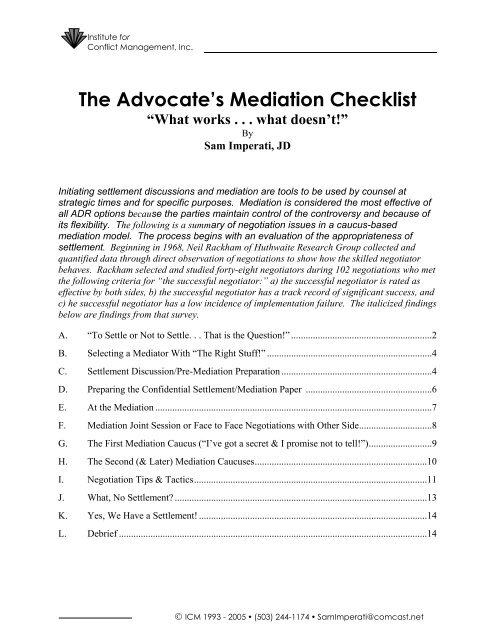
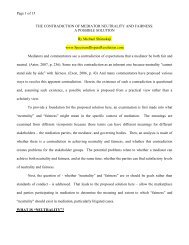

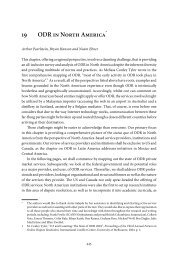
![Settlement Agreement Form [Agreement] - Mediate.com](https://img.yumpu.com/50682143/1/190x245/settlement-agreement-form-agreement-mediatecom.jpg?quality=85)


